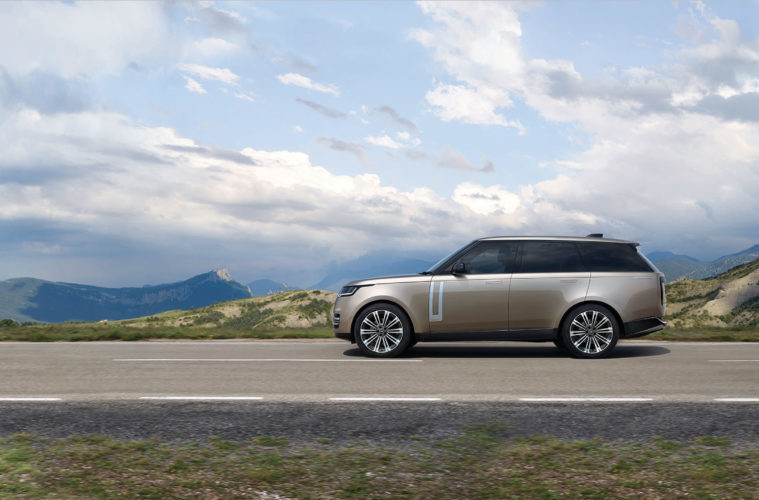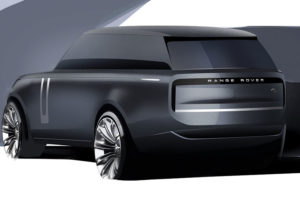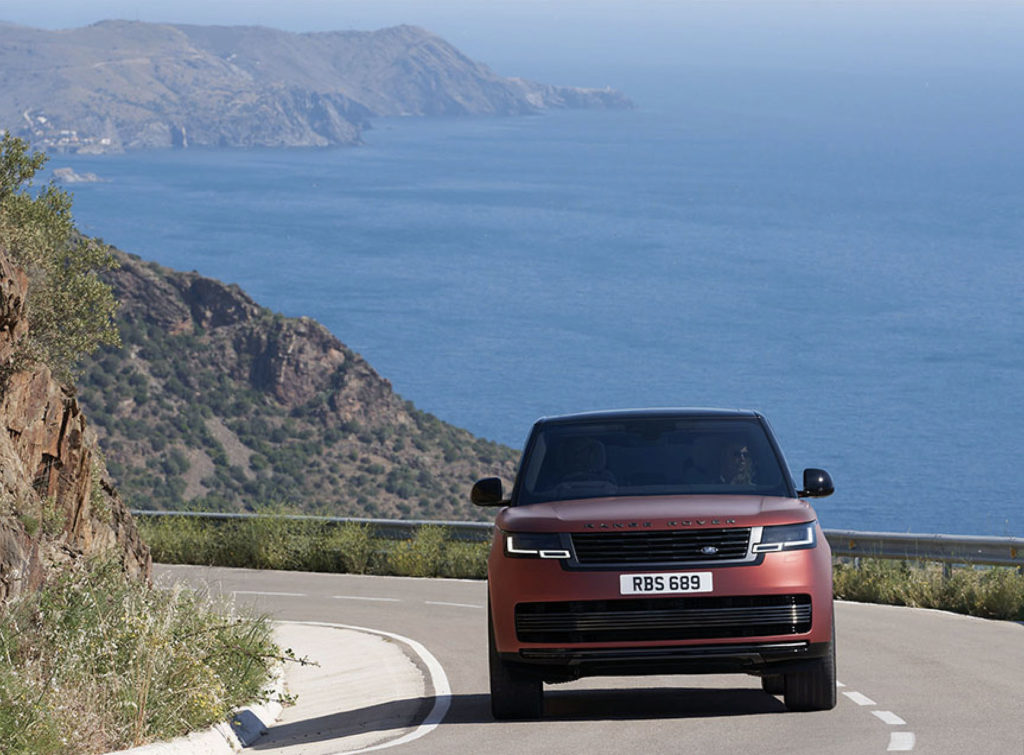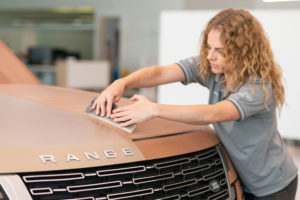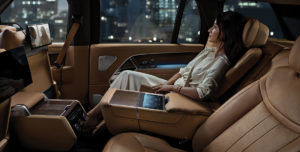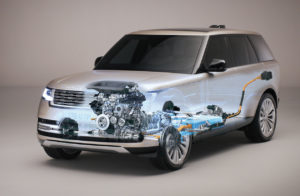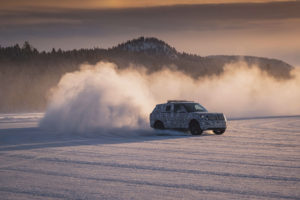Every ten years or so, Jaguar Land Rover introduces a new Range Rover with design
and engineering features that link the generations. Last November, JLR introduced the 5th generation Range Rover at the Los Angeles Auto Show for the MY 2022.
JLR organized a well-attended “Range Rover Leadership Summit” event just prior to the show’s opening day, featuring luminaries from CEOs (Thasunda Duckett, Andreas Fibig), to athletes (Lindsey Vonn, Gabby Reece), food influencers (Kim Alter), musicians (Wyclef Jean, Biggs Burke), social media moguls (Angela Courtin) and entertainment movers and shakers (James Corden). The large, socially distanced crowd of attendees also got a preview of the new Range Rover.
By automotive industry standards, Range Rovers have a long shelf life. The Range Rover line started in 1970 with the retroactively named Range Rover Classic. With the
creation of a 4-door version, it arrived in North America in 1987 and remained in production until 1995 [see Summer 2020 issue -ed]. Its successor, the P38A, sold in greater numbers despite a reputation for troublesome electronics (one ex-pat named his beloved Range Rover “The English Patient”). In 2002, Land Rover replaced the P38A with the third-generation L322 series, which grew the lineage to include the Range Rover Sport. By then, over 500,000 Range Rovers had been sold worldwide. In 2012, the fourth-generation L405 series arrived with monocoque construction and significant weight reduction [see Summer 2021 issue -ed].
The design cues of the Range Rover that have been imbedded in previous generations – proportionality, slightly pitched roofline, flowing belt line, clamshell tailgate – remain today. With JLR Chief Creative Director Gerry McGovern’s emphasis on “reductive design,” the newest model flows from engineering and styling emphases first seen in the 2018 Range Rover Velar. Massimino Frachelli’s interior work on the Velar clearly influenced decisions regarding the new Range Rover [see Winter 2018 issue -ed]. One benefit of the exterior design is a .30 Cd, remarkable for a vehicle of its size.
Range Rovers have hardly been exemplars of bling (see Escalade, Cadillac) but this 5th iteration growls “Bah, humbug,” at any hint of exterior trim. Even the horizontal grille and the vertical grilles in front of the A pillar lack adornment. With its striking rear taillights and clamshell tailgate, you’ll instantly know it was a Range Rover that just passed you. The rest of the body looks like a sculptor hewed it out of an ingot.
This 5th generation sits on a new platform, the MLA-Flex, that’s over 75% aluminum, with even greater torsional rigidity than the L405. There are two wheelbases, 118 inch or 126 inch, the latter enabling the creation of Range Rover’s first 7-seater; the Range Rover’s market competition, especially in the US, really called for this super-sized version. Land Rover’s engineers managed to add length and width without wildly adding weight; at 5,240 lbs empty, the 5th gen is within 37 lbs. of its predecessor.
Engine choices start with the base 3.0L inline 6-cylinder (395 hp/406 ft-lbs. torque) with a 48-volt hybrid assist, and move up to a 4.4L V-8 (523 hp/553 ft lbs) designed in collaboration with BMW. Future options will include a plug-in hybrid 6-cylinder (434 hp/516 ft lbs) for MY 2023 and later yet, a fully electric version. An 8-speed transmission and AWD that can disconnect the front axle helps the Range Rover achieve an EPA mpg rating of 18 city/23 highway. The six off-road Terrain Response modes, combined with 11.6 inches of ground clearance and three-foot wading depth, assure that if you wish to risk mud on the carpeting, your Range Rover will tackle off-road challenges as well as any Land Rover.
The Range Rover will be available in SE and Autobiography models. For 2022 only, a First Edition model based on the Autobiography will feature unique specifications. Despite the extra length, the Range Rover has a 36-ft turning circle (versus 40 ft for the L405) due to its new 4-wheel steering. The rear wheels will pivot 7 degrees to make the 197 inch/207 inch long vehicle easier to maneuver. Yes, that’s additional complexity, but it will prove helpful off-road, too.
If neither the SWB nor LWB version offers sufficient exclusivity for its new owners, Land Rover will manufacture the Range Rover SV as a 2023 model. Enthusiasts might remember the stillborn 2018 Range Rover SV two-door coupe [see Spring 2018 issue -ed], deemed too resource-intensive even at its projected $295,000 price (but a bargain compared to the $325,000 2018 Rolls Royce Cullinan.) For MY 2023, JLR’s Special Vehicle Operations will create a personalized Range Rover SV from a vast palette of colors, interior leathers or fabrics, wood inlays – even ceramic control knobs. One unique seating arrangement will include a motorized folding table and touchscreens for the rear passengers.
Hidden underneath every Range Rover are innovative technologies to minimize NVH (noise, vibration and harshness), from the body architecture to headrest speakers that mimic noise-canceling headphones. Easing the challenges of voice commands, JLR builds Amazon’s Alexa into the infotainment system, now included in the 13.1 inch touchscreen. Happily, real knobs for routine features like climate control duplicate actions on the touchscreen.
New Range Rovers have always fetched a premium price, and in the inflated market of 2022, JLR has kept up with its competition. JLR sold over 19,000 Range Rover in the US until the pandemic and computer chip shortage reduced manufacturing in 2020 and 2021. Given its technical and design enhancements, the 5th generation Range Rover will retain its preeminence amongst the world’s top vehicles.
25 years ago, Range Rover’s winter advertising promised to “Get You to Your Cancelled Flight on Time.” We’re eager for a test drive to see if the new Range Rover can fulfill that promise.
